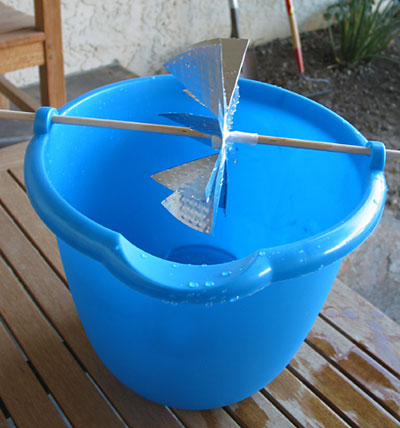| Making a small water powered generator is quite an easy task. The parts are shown below and include a propeller (which can be homemade) and a cheap electrical motor (3 to 6v). The motor is held in a piece of wood shape to form a handle. A multimeter is set to read volts and connected using crocodile clips to the positive and negative probes. Spinning the propeller by hand is normally enough to produce 0.3 to 0.6 volts. This can clearly be seen on the multimeter. If the homemade wind generator is placed... Building a Water-Powered Generator. |
| Take your scissors and cut out the flat bottom part of the aluminum pie plate. With the permanent marker, copy the design from the waterwheel template (Figure 5) onto the circle of aluminum. Draw the lines from the edge of the circle to about 2 centimeters (cm) from the middle of the circle. Cut the aluminum circle along the eight solid lines. End each cut at 2 cm from the center. These are the paddles of the waterwheel. Carefully bend each paddle at its dotted line. Put the ruler at each dotted line so that you can make a... Using Hydropower to Lift a Load |
| Students learn the history of the waterwheel and common uses for water turbines today. They explore kinetic energy by creating their own experimental waterwheel from a two-liter plastic bottle. They investigate the transformations of energy involved in turning the blades of a hydro-turbine into work, and experiment with how weight affects the rotational rate of the waterwheel. Students also discuss and explore the characteristics of hydroelectric plants.Throughout human history, waterwheels performed many types of mechanical work: saw timber, drive pumps, run farm equipment, trip hammers, grind... Waterwheel Work: Energy Transformation and Rotational Rates |




 RSS Feed
RSS Feed

